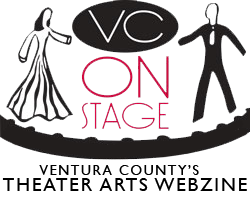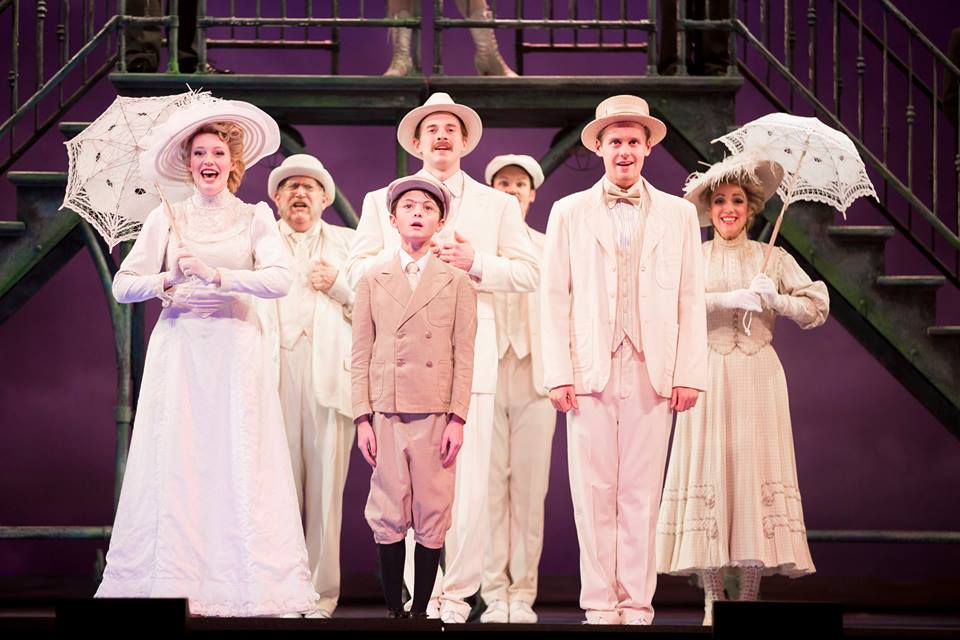REVIEW BY CARY GINELL
At the beginning of Act II of Ragtime, Terrence McNally’s masterful musical adaptation of E. L. Doctorow’s novel, journeyman pianist Coalhouse Walker Jr., decimated by the murder of his beloved Sarah, sings, “Say goodbye to music / Say goodbye to light.” This sums up my feelings about Theater League’s production of Ragtime, which arrived for a brief four-day stay at the Thousand Oaks Civic Arts Plaza on Thursday night. The original 1998 Broadway production won a Tony Award for Best Score, but many patrons who packed the Fred Kavli Theatre on opening night were dismayed to discover that Lynn Ahrens and Stephen Flaherty’s sumptuous, moving songs were being played from pre-recorded synthesized music tracks. Despite superb performances from the entire cast, Theater League’s Ragtime suffers greatly from this omission, which was apparently a decision of Phoenix Entertainment, the independent theatrical producing and management enterprise in charge of producing the show.
It is ironic that only days before, Cabrillo Music Theatre, the resplendent resident production company for the Civic Arts Plaza, announced that it was ceasing production of its own musicals after 22 years. During those times, Cabrillo never once cut corners or diluted its productions, including its use of professional musicians, and it was that dedication to excellence that helped contribute to its downfall. This only made Theater League’s decision to stage an impecunious production that much more unfortunate. As one disappointed patron told me, “This company is defrauding its customers by promising a musical and then having no live musicians.”
It would have been one thing if the recording was that of a full orchestra. We understand the prohibitive costs of transporting and housing a large symphony orchestra on a national tour. But Phoenix Entertainment never even bothered to craft a reputable soundtrack. Instead, we got what sounded like synthesized instruments whose sound resembled that of an electronic calliope, with a teeth-rattling sub-woofer that spoiled all of the show’s luxuriant melodies, especially Mother’s solos (“What Kind of Woman” and “Back to Before”) and Sarah’s emotional “Your Daddy’s Son.” The grand, magisterial prologue, one of the most stirring openings of any show in musical history, was disappointing and underwhelming due to the thin musical backdrop. I was told that there were actually two musicians in the house, but the Kavli Theatre’s expansive orchestra pit remained covered over and dark. For a national tour of an iconic, masterful musical such as Ragtime, this is not only unforgivable, but insulting to its audiences, who paid premium prices (topping out at $85) to see it.
VC On Stage reviews all kinds of productions, from middle and high school companies that are manned by students and parents to professional organizations with complex budgets. We can certainly understand facilities like the High Street Arts Center in Moorpark or the Rubicon Theatre Company in Ventura simply not having the physical space to house an orchestra, but not to have one at the multi-million dollar Kavli is nothing short of criminal. Just think of someone seeing Ragtime for the first time. I remember my first time – it was at the old Shubert Theatre in 1997 and the effect that production had on me has stayed with me since that memorable performance. You can bet they had a full orchestra there during that run.
The especially tragic thing about Theater League’s Ragtime is that the Conejo Valley and the surrounding areas are inundated with talented musicians, many of whom would jump at the chance to perform a show with such a rich history as Ragtime, even without compensation. Cabrillo Music Theatre’s orchestras always enhanced its productions with quality union musicians, and as Cabrillo’s artistic director Lewis Wilkenfeld says before every performance, “You can’t have live musical theater without live music.”
As much as the absence of live music marred the production, none of this is meant to detract from the outstanding jobs turned in by the on-stage performers. The cast is led by Chris Sams, who gives a powerful performance as Coalhouse Walker Jr. The chemistry Sams has with co-star Leslie Jackson, who played Sarah, is magical, and when the two of them combine their voices on the exquisite “Sarah Brown Eyes” and the standout anthem of the show, “The Wheels of a Dream,” the ovations sweep through the theater like a tidal wave.
Kate Turner turns in an equally excellent and fully-rounded performance as Mother, the true heroic figure of the show. The characters of Coalhouse and Mother complement each other, as they grow in opposing developmental arcs – Mother emerging from her sheltered, upper-class cocoon to show empathy and caring for the African American and Jewish immigrants who come into her life – while Coalhouse goes in reverse, starting out as a hopeful, idealistic piano player discovering the “New Music” of ragtime, and then being transformed into an unrepentant vigilante monster, bent on destroying anything and everything that comes in his path.
Donald Coggin shows passionate idealism as Mother’s volatile younger brother while Troy Bruchwalski is Father, confused at the changes that enveloped his household while he was on a North Pole expedition. Matthew Curiano plays the Jewish immigrant Tateh with verve and humor, excelling especially in his performance of “Gliding.”
One of the brilliant mechanisms of Ragtime is its use of actual historical figures to comment on the action as well as interact with the other characters. Best of the lot is Sandy Zwier as the fiery anarchist Emma Goldman, but outstanding performances are also exhibited by Jeffrey Johnson II as black educator/activist Booker T. Washington, Jillian Van Niel as tabloid starlet Evelyn Nesbit, Mark Alpert as illusionist escape artist Harry Houdini, and Todd Berkich as financier J. P. Morgan.
One especially delightful performer is Colin Myers (double-cast with Jordan Santiago), who plays Edgar, the prescient little boy who eagerly says whatever is on his mind, often to the dismay of his parents.
In accordance with its 2009 revival, Ragtime is stripped of all the expensive sets of the original production, leaving its bare essentials (no doubt to the relief of the penny pinching Theater League), with the action centering around two interlocking staircases, which are wheeled around the stage from scene to scene. Skeletal framework representing Coalhouse’s piano and automobile are effective as are Tateh’s pushcart, from which he displays his silhouette art, and the circus-like carnival scene of “Crime of the Century.” Fortunately, none of this really matters, and the audience is better able to focus on the story, characters, and music without all the excessively ornate set accouterments.
Looking at Ragtime from the vantage point of its 20th anniversary year (it began in Toronto in 1996), we find the story even more relevant than ever, especially given the incendiary nature of today’s political landscape and current social upheavals. Many contemporary figures can be seen in Ragtime‘s characters, such as the one-percenter Koch Brothers (J. P. Morgan & Henry Ford), the Kardashian sisters (Evelyn Nesbit, who delivers the ironic line, “I’m not an actress, I’m a personality!”), and Donald Trump (who can be seen in a number of the more intolerant characters like Father, Grandfather, and Willie Conklin). Despite its quaint setting and the gentle ragtime music that lilts throughout the score, Ragtime proves that old axiom that “the more things change, the more things stay the same.” We can’t look down on the people who lived at the dawn of the 20th century as being simple, ignorant, and narrow-minded, because they are still among us. The characters of Coalhouse, Mother’s Younger Brother, and their vigilante cohorts come uncomfortably close to the wave of terrorism that has disrupted our society, in which it is no longer possible to safely patronize public places without fear of the unexpected happening.
In a recent interview, Chris Sams, who plays Coalhouse Walker, told me that Ragtime “is a show that is not meant for you to escape through, it’s to make you listen and realize things about the world that we live in.” As time goes on, Ragtime‘s impact will continue to grow as an emotionally moving and thought-provoking masterpiece of American theater. Next time, do it with an orchestra.
*********************
Ragtime plays through Sunday at the Fred Kavli Theatre. For tickets, visit www.theaterleague.com/thousandoaks.






Mark Edelman
•8 years ago
The live musicians, conducted by Daniel Doss, performed arrangements supervised and approved by Lynn and Stephen from backstage, a creative decision of director Marcia Milgrom Dodge, who directed the recent Broadway revival of RAGTIME.
I would hate to think people would read your notice and miss this wonderful production. You’re going to have to wait many years to get a better RAGTIME.
Cary Ginell
•8 years ago
I will acknowledge the presence of an undefined number of musicians but can only wonder why the orchestra pit was not used, nor were any musicians credited in the program. Even so, live or recorded, the thin, electronic sound cannot be compared to a large, live orchestra in the orchestra pit, especially for such a score. We understand the financial constraints of hiring live musicians, but for such a program, in our opinion, it reduces the splendor of the “Ragtime” score. I saw the revival on Broadway in 2009 and was incredibly moved by the beauty of the music; it’s sad that touring companies have to be reduced to using artificial instruments.
Paul Bryant
•8 years ago
I loved the article of the Kavali theater, and Ragtime. I had the opportunity to direct Ragtime at that theatre in 2004 with a live orchestra. You are so right about the score being an award winning score. It’s sad to think that people are being charged such fees to see great theatre , and are being cheated of musical theatre in this fashion. I ask. Where is all that profit going?
Anyway, I loved the article. Ragtime has been a part of my life since the Ex-Schubert in Century City. I was in the
That company, and went on to tour with the 1 St and 2nd national tours. Have directed and choreographed more than 13 productions. So very glad that you are helping to keep the story alive. “Make them hear you”. More prevalent today than ever. Thank you!
PDB
Cary Ginell
•8 years ago
Your words are very meaningful to me, Paul. I saw the Shubert production back in 1998, I think it was. It was the first time I ever saw “Ragtime” and it absolutely blew me away. I have never forgotten the experience. I can’t even imagine seeing this show for the first time with synthesizers playing the score instead of an orchestra. – Cary Ginell
Justina Ercole
•8 years ago
So if they aren’t paying all those musicians, where is the extra money going? Not to the NON UNION actors making pennies! It goes straight to the producers. #askifitsequity